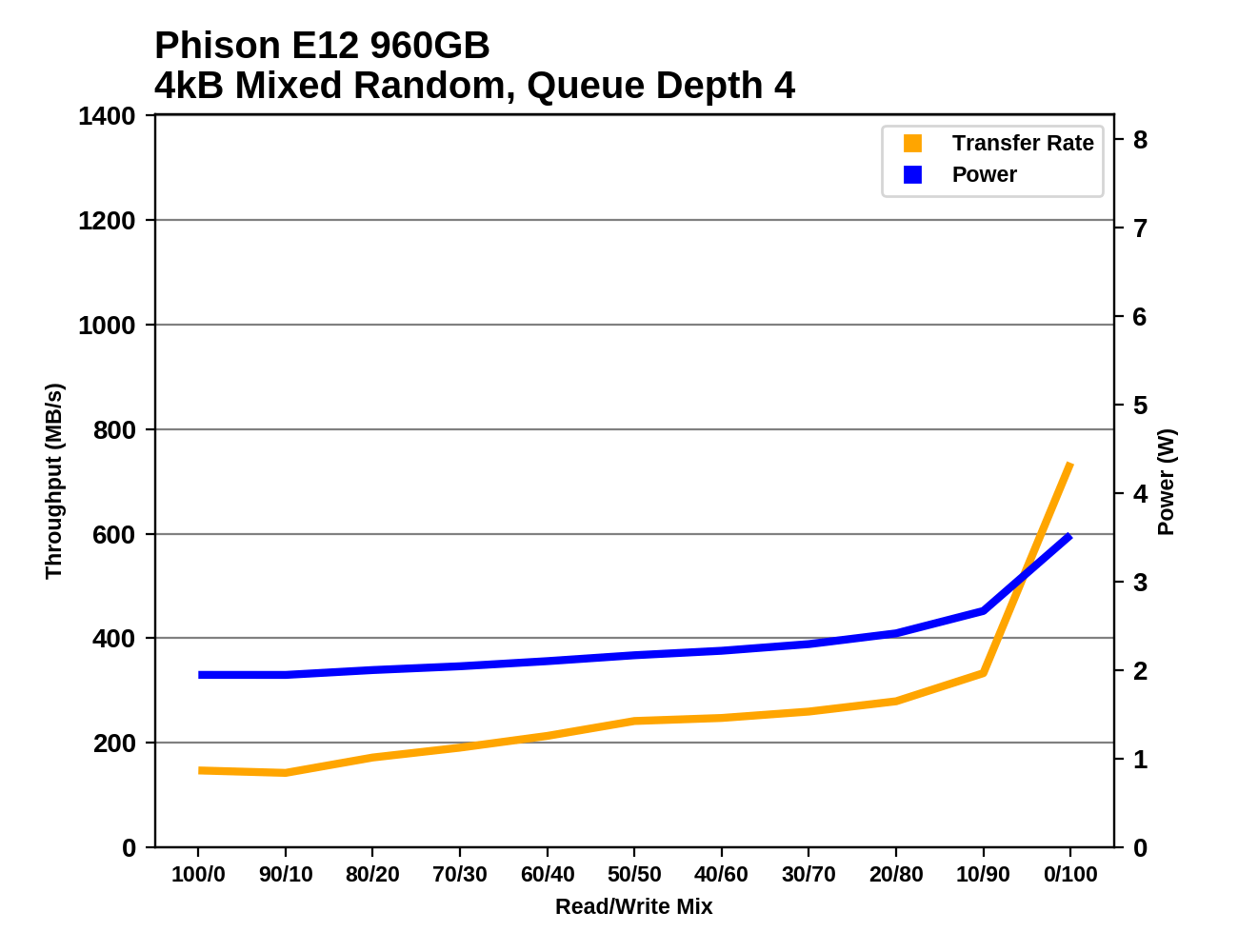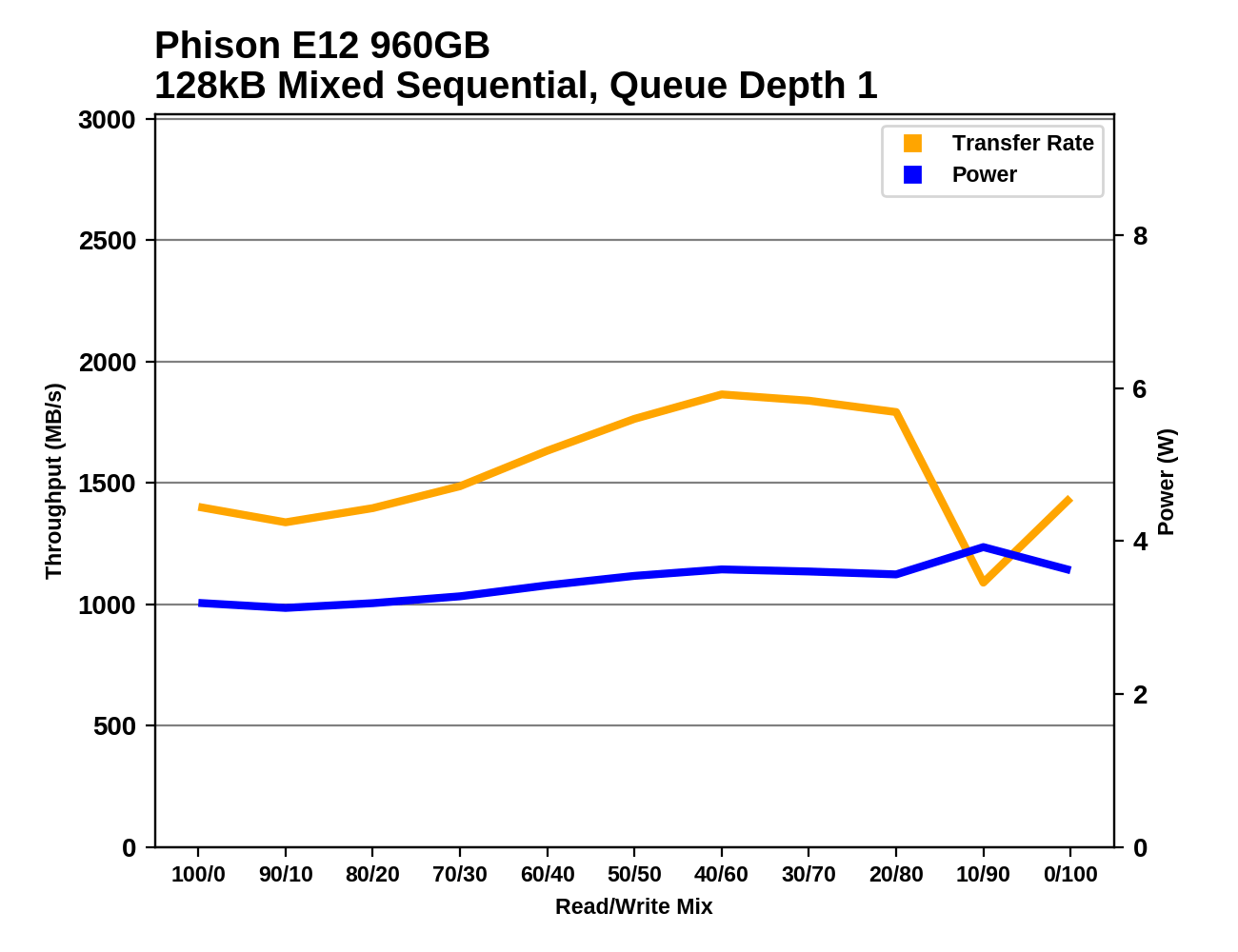The Phison E12 Reference Design Preview: A Next-Gen NVMe SSD Controller
by Billy Tallis on July 18, 2018 10:30 AM ESTMixed Random Performance
Our test of mixed random reads and writes covers mixes varying from pure reads to pure writes at 10% increments. Each mix is tested for up to 1 minute or 32GB of data transferred. The test is conducted with a queue depth of 4, and is limited to a 64GB span of the drive. In between each mix, the drive is given idle time of up to one minute so that the overall duty cycle is 50%.

The mixed random I/O performance of the Phison E12 is unimpressive for its intended market segment: The HP EX920 and WD Black are 20% faster overall and the Samsung 970 EVO is 40% faster. The E12 delivers only a modest improvement over the previous-generation E7 controller.
 |
|||||||||
| Power Efficiency in MB/s/W | Average Power in W | ||||||||
The power efficiency of the Phison E12 during the mixed random I/O test is better than most TLC SSDs, but it is slightly beat out by the low-power Toshiba XG5 and top-performing Samsung 970 EVO, and they're all overshadowed by the extremely efficient WD Black.
 |
|||||||||
The Phison E12 gains performance slowly as the test progresses from pure reads toward write-heavy workloads. At the very end of the test the high random write speed of the Phison E12 helps bring the average up, but not enough to overcome the drives that show much more pronounced performance growth throughout the test.
Mixed Sequential Performance
Our test of mixed sequential reads and writes differs from the mixed random I/O test by performing 128kB sequential accesses rather than 4kB accesses at random locations, and the sequential test is conducted at queue depth 1. The range of mixes tested is the same, and the timing and limits on data transfers are also the same as above.

The mixed sequential I/O performance of the Phison E12 is very good, beating all TLC drives except the Samsung 970 EVO, which is only about 7% faster overall.
 |
|||||||||
| Power Efficiency in MB/s/W | Average Power in W | ||||||||
The power efficiency of the Phison E12 on the mixed sequential test is again very good, but still can't match the WD Black. Toshiba/SanDisk BiCS3 3D TLC seems to be very efficient for sequential I/O, but Phison's controller is a bit more power-hungry than Western Digital's in-house controller.
 |
|||||||||
The Phison E12 starts the test with a middling sequential read speed, but it barely loses any performance when writes are added to the mix and instead turns around to deliver modest performance growth, peaking in the second half of the test when most drives are at their worst. Near the end, the write volume is high enough that the E12's slow garbage collection begins to hurt performance.










28 Comments
View All Comments
Tastydirt - Sunday, August 5, 2018 - link
Not necessarily, depending on workload. A drive like this will read/write 4-8x faster than a SATA drive, allowing it to drop back into idle state much faster. This would probably result in lower total power consumption per byte read.DanNeely - Wednesday, July 18, 2018 - link
looks like a solid design to me, no bad results anywhere and optimizing for low latency over peak throughput in consumer scenarios is probably the better choice.takeshi7 - Wednesday, July 18, 2018 - link
I wish they kept the flip chip BGA design of the E7. It just looks cooler with the exposed die.imaheadcase - Wednesday, July 18, 2018 - link
Plan on admiring it inside case huh?FATCamaro - Wednesday, July 18, 2018 - link
He’s going to watch all those bits moving around the chip.Alistair - Wednesday, July 18, 2018 - link
A nice new possibility, but like the HP drive surprised me when I opened it, the Phison is double-sided unfortunately. I'd rather not buy Samsung, but Samsung being single-sided is a big plus.imaheadcase - Wednesday, July 18, 2018 - link
A big plus for what?DanNeely - Wednesday, July 18, 2018 - link
compatibility with laptops that don't have enough Z height for a 2 sided m.2 card.romrunning - Thursday, July 19, 2018 - link
It can also help with the cooling, if the controller is being impacted by higher thermals. The board-facing side may not have enough space to add even a small heatsink. Single-sided M.2 drives can benefit from placing the heatsink on the top side, along with whatever better airflow there may be the top side as well.siuol11 - Wednesday, July 18, 2018 - link
I really wish someone besides Samsung would make a "performance" drive with MLC, I'm not interested in using a TLC drive for a windows install. AFAIK there are no direct competitors to Samsung's Pro drives, and the prices have consequently continued to stay high.